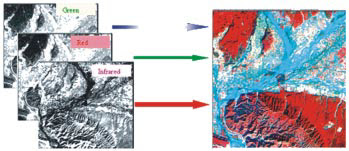Structure of a Digital Image and Multispectral Image
According wikipedia Digital image processing is the use of computer algorithms to perform image processing on digital images. As a subcategory or field of digital signal processing, digital image processing has many advantages over analog image processing. It allows a much wider range of algorithms to be applied to the input data and can avoid problems such as the build-up of noise and signal distortion during processing. Since images are defined over two dimensions (perhaps more) digital image processing may be modeled in the form of Multidimensiona.
History
Many of the techniques of digital image processing, or digital picture processing as it often was called, were developed in the 1960s at the Jet Propulsion Laboratory, Massachusetts Institute of Technology, Bell Laboratories, University of Maryland, and a few other research facilities, with application to satellite imagery, wire-photo standards conversion, medical imaging, videophone, character recognition, and photograph enhancement. The cost of processing was fairly high, however, with the computing equipment of that era. That changed in the 1970s, when digital image processing proliferated as cheaper computers and dedicated hardware became available. Images then could be processed in real time, for some dedicated problems such as television standards conversion. As general-purpose computers became faster, they started to take over the role of dedicated hardware for all but the most specialized and compute-intensive operations.With the fast computers and signal processors available in the 2000s, digital image processing has become the most common form of image processing and generally, is used because it is not only the most versatile method, but also the cheapest.
Digital image processing technology for medical applications was inducted into the Space Foundation Space Technology Hall of Fame in 1994.
COLOR COMPOSITES
While displaying the different bands of a multispectral data set, images obtained in different bands are displayed in image planes (other than their own) the color composite is regarded as False Color Composite (FCC). High spectral resolution is important when producing color components. For a true color composite an image data used in red, green and blue spectral region must be assigned bits of red, green and blue image processor frame buffer memory. A color infrared composite ‘standard false color composite’ is displayed by placing the infrared, red, green in the red, green and blue frame buffer memory (picture below). In this healthy vegetation shows up in shades of red because vegetation absorbs most of green and red energy but reflects
approximately half of incident Infrared energy. Urban areas reflect equal portions of NIR, R & G, and therefore they appear as steel grey.
False Color Composite (FCC) of IRS : LISS II Poanta area


1 comments:
Very professional blog... you have created !
Wong
Post a Comment